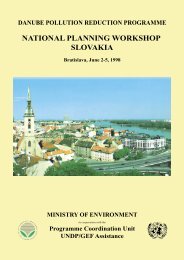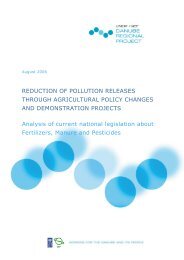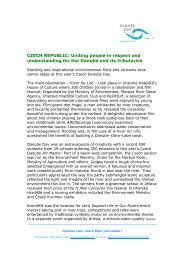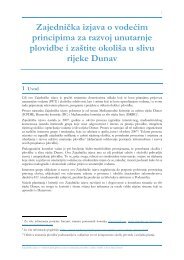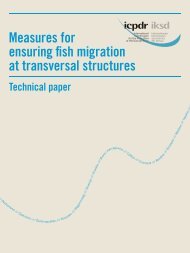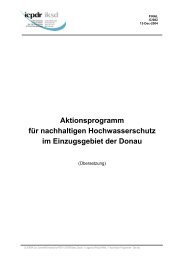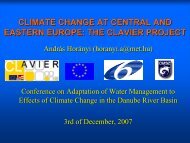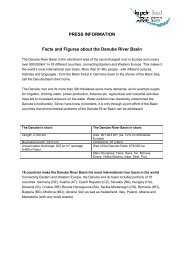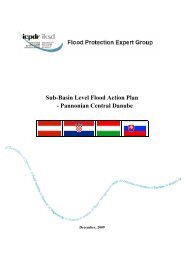Technical Reports Parts C,D - ICPDR
Technical Reports Parts C,D - ICPDR
Technical Reports Parts C,D - ICPDR
Create successful ePaper yourself
Turn your PDF publications into a flip-book with our unique Google optimized e-Paper software.
4. Updating and Validation of Water Quality Data<br />
Selection of monitoring sites of the ambient water quality was closely related with hot spots. For<br />
the major pollution sources the monitoring sampling is performed upstream and downstream from<br />
pollution sources.<br />
Water quantity data are usually well linked with water quantity data when sampling is performed<br />
by the State Committee of Hydrometeorology. Quality data produced by other agencies are not<br />
well connected with water quantity data.<br />
The analytical techniques and measured variables for years 1990-1995 are presented in Annexes.<br />
These data were compiled for the Inventory of the Current Practices in Monitoring and Assessment<br />
of Transboundary Rivers under the activity of the UN/ECE Task Force on Monitoring and<br />
Assessment of Transboundary Waters (1996).<br />
4.1. Index of Water Quality Monitoring Records<br />
See Annex, Table 6.7.<br />
4.2. Data Quality Control and Quality Assurance<br />
Data Quality Control and Quality Assurance are the responsibilities of Central Analytical<br />
Laboratories of each institution involved in monitoring activities within their monitoring networks.<br />
All of them are located in Kiev.<br />
The most common procedures for quality control are distribution to regional laboratories spiked<br />
samples or “control samples”. Each analytical laboratory works by analytical techniques and by<br />
protocol approved by relevant agency. If on the whole the control system is rather efficient, many<br />
laboratories do not have modern equipment to perform a complete set of sophisticated analyses.<br />
For example, in Zakarpattia State Ecological Inspection a gas chromatograph was manufactured in<br />
1984 in the Former Soviet Union.<br />
The quality assurance of the analytical works is implemented through the relevant analytical<br />
protocols, established procedures of operation, and reporting system.<br />
4.3. Data Consistency, Compatibility and Transparency<br />
Institutions involved in monitoring are listed as follows:<br />
- Regional State Ecological Inspections - RSEI<br />
- State Committee of Hydrometeorology - SCHM<br />
- State Committee on Water Management -SCWM<br />
- Ministry of Health Care -MHC<br />
Regional State Ecological Inspections, regional divisions of the State Committee of<br />
Hydrometeorology, State Committee on Water Management and Ministry of Health collect,<br />
analysis and produce raw analytical data. Similar analytical data in all above-mentioned agencies<br />
are performed by the standard analytical techniques approved by State Standard Service. Those<br />
data are compiled processed and reported to the relevant headquarters.<br />
State Committee of Hydrometeorology performs the background monitoring and pollution<br />
monitoring of the water bodies and watercourses. Regional State Ecological Inspections monitor<br />
the compliance with norms and permits of discharges. The State Committee on Water<br />
Management is responsible for performing the effluent monitoring. The Ministry of Health is



